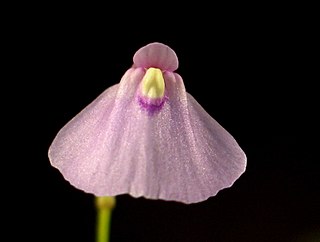
Utricularia dichotoma, commonly known as fairy aprons, is a variable, perennial species of terrestrial bladderwort. The specific epithet is Latin for "dividing into pairs" and refers to the double arrangement of flowers which this species often displays.

Utricularia multifida, commonly called pink petticoat or fairy aprons, is a terrestrial carnivorous plant that belongs to the bladderwort genus, Utricularia, of family Lentibulariaceae. It is endemic to the south west corner of Western Australia. It was once placed in a separate genus as Polypompholyx multifida.
Utricularia dunlopii is an annual terrestrial carnivorous plant that belongs to the genus Utricularia. Its distribution ranges from Western Australia to the Northern Territory.
Utricularia dunstaniae is an annual terrestrial carnivorous plant that belongs to the genus Utricularia. Its distribution ranges from northern Western Australia to the Northern Territory.
Utricularia georgei is an annual terrestrial carnivorous plant that belongs to the genus Utricularia. It is endemic to northern Western Australia.
Utricularia lasiocaulis is an annual terrestrial carnivorous plant that belongs to the genus Utricularia. Its distribution ranges from Western Australia through the Northern Territory and into Queensland, Australia.
Utricularia leptorhyncha is an annual, terrestrial carnivorous plant that belongs to the genus Utricularia. Its distribution ranges from Western Australia to the Northern Territory.

Utricularia menziesii, commonly known as redcoats, is a perennial, terrestrial carnivorous plant that belongs to the genus Utricularia. It is endemic to the coastal regions of Western Australia.
Utricularia quinquedentata is an annual, terrestrial carnivorous plant that belongs to the genus Utricularia. Its distribution ranges across northern Australia from Western Australia to northern Queensland and south to Brisbane. It was first identified by Ferdinand von Mueller as possibly a new species or variety in the early 1890s, noting it as "U. albiflora or a closely allied species." Mueller labeled one herbarium sheet as Utricularia albiflora var. quinquedentata. Without a valid description, according to the rules of botanical nomenclature, however, the epithet quinquedentata was not recognized until Peter Taylor validly published the species in 1986.
Utricularia pachyceras is a terrestrial carnivorous plant that belongs to the genus Utricularia. It is endemic to Western Australia and the Northern Territory.
Utricularia tubulata is a suspended aquatic carnivorous plant that belongs to the genus Utricularia. Its distribution ranges across northern Australia from Western Australia through the Northern Territory and into Queensland.

Utricularia volubilis, the twining bladderwort, is a perennial, affixed aquatic carnivorous plant that belongs to the genus Utricularia. It is endemic to the southwestern coastal region of Western Australia.
Utricularia leptoplectra is a terrestrial or subaquatic carnivorous plant that belongs to the genus Utricularia. It is endemic to Australia with a distribution in the Northern Territory from the area around Darwin, east to the Arnhem Land plateau, south to Katherine, and west to the western Kimberley region in Western Australia.
Utricularia limosa is a terrestrial or subaquatic carnivorous plant that belongs to the genus Utricularia. It is endemic to Australia and Southeast Asia with distributions in China, Laos, Malaysia, New Guinea, the Northern Territory, Queensland, Thailand, Vietnam, and Western Australia.

Utricularia aurea, the golden bladderwort, is a medium- to large-sized suspended aquatic carnivorous plant that belongs to the genus Utricularia. It is the most common and widespread suspended aquatic species in Asia. Its native distribution ranges from India to Japan and Australia.

Utricularia stellaris is a medium to large sized suspended aquatic carnivorous plant that belongs to the genus Utricularia. U. stellaris is native to Africa, tropical Asia, and northern Australia.

Utricularia simplex, commonly known as bluecoats, is a very small perennial carnivorous plant that belongs to the genus Utricularia. U. simplex is endemic to Western Australia. It grows as a terrestrial plant in peaty soils in heathland or swamps at altitudes near sea level. It was originally described and published by Robert Brown in 1810.
Utricularia odorata is a medium-sized, probably perennial carnivorous plant that belongs to the genus Utricularia. It is native to southeastern Asia and northern Australia. U. odorata grows as a terrestrial plant in wet grasslands at low altitudes. It was originally described by François Pellegrin in 1920. The specific epithet odorata is derived from reports that the flowers are fragrant.

Utricularia uliginosa, the Asian bladderwort, is a small annual carnivorous plant that belongs to the genus Utricularia. It is native to Southeast Asia, Oceania, and Australia. U. uliginosa grows as a terrestrial or subaquatic plant in seasonally flooded shallow pools with sandy soils or on banks and among rocky stream beds at low altitudes. It was originally described by Martin Vahl in 1804.

Australia has one of the world's richest carnivorous plant floras, with around 187 recognised species from 6 genera.








